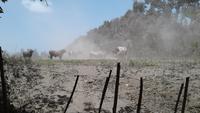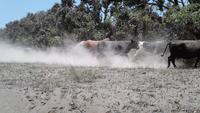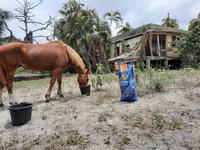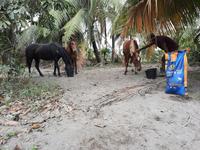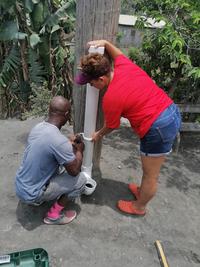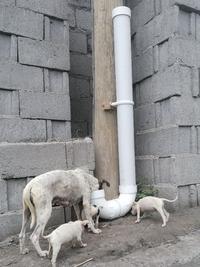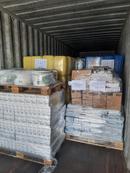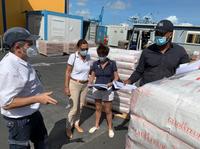SVG La Soufriere Volcano Eruption 2021: CaribVET involvement
The La Soufriere Volcano in St. Vincent and the Grenadines (SVG) became active on 27th December 2020. This activity involved a series of effusive eruptions, which continued into April 2021 and resulted in the formation of a new lava dome. On April 9th 2021, the volcano transitioned to explosive eruptions which continued episodically up to the 22nd April, 2021.
A few days before the eruption, the CaribVet Network commenced discussions to consider the importance of the situation, to have an overview of all activities and the necessary actions that would be taken in the event of an explosion.
The first signs of imminent danger appeared a few days before La Soufrière’s eruption. This heightened volcanic activity prompted authorities to begin the evacuation of thousands of citizens living in the zones classified as red and orange on Thursday April 8th, 2021. People were evacuated by sea and land without being able to take their belongings and furthermore their pets or livestock.
The issue the animals, pet and livestock, left behind remained shrouded with many unanswered questions. What would happen if the dogs returned to a life in wild packs? How would animals live in abandoned farms? What sanitary threat may these animal face in a devastated environment? What biodiversity issue such a disaster may pose? What would be the risks of disease transmission from wildlife to humans during a gradual return to normal? These were some of the questions, the members of the CaribVet network[1] have asked themselves as soon as the first alarming signs appeared.
|
|
|
|
|
|
|
|
|
Often, during a hazard event or disaster, detailed description, logging of events and keeping track of activities and communication can prove to be most difficult. With this in mind, and in order to achieve a fast and efficient communication between members, CaribVET set up a WhatsApp group (one of the most used application for rapid communication in the Caribbean) from the 3rd of April, 2021: the Volcano Response WhatsApp group for small animals and livestock needs. This group quickly grew with the addition of many key stakeholders and experts across the region. The CaribVET network also organised meetings in order to link local groups (from Jamaica, Trinidad and Tobago, Guadeloupe, Martinique, Cuba, etc.) and international organisations with experience in natural disaster response management.
The CaribVET network’s main task from the beginning was to coordinate response actions relating to pets and livestock and ensure that the help provided corresponded to the needs identified. Therefore, the first task that was done was the compilation of a list of the needs for St Vincent and Grenadines (SVG) animal health and welfare according to the census of animals that were present in the red zone. This compilation was organised through a shared spreadsheet to which all the members have access. This document provides background information with focal points contacts, logistic and funding information, protocol for shipment, the main initiatives undertaken by CaribVET and obviously some sheets dedicated to the needs in terms of feed, material and medicine. Some other sheets were prepared for the foreseen assistance members would provide. This shared document allows to coordinate and to keep track of all actions. This type of document was an example and a test of what should be developed within an integrated Collaborative Coordination tool currently in development.
The preparedness phase was short-lived. Then very shortly after the eruption, regional and international response actions started:. all the CaribVET community engaged in assisting SVG to the extent of their capacity: Trinidad and Tobago, Guyana, Barbados, Bermuda, Martinique, Guadeloupe and Jamaica sent an ample supply of water and feed for livestock and pets as early as the 13th of April 2021.
Alongside with government engagements of the Caribbean countries, specialized centres such as the UWI Disaster Risk Reduction Centre and the CENSA in Cuba (OIE Collaborating Centre for Reduction of the Risk of Disasters in Animal) mobilized in order to offer advice to SVG Veterinary Services.
The CaribVET community also partnered with other stakeholders willing to help with specific relief activities for animal health and welfare, which are too often neglected in cases of natural disasters. The Caribbean veterinary medical association was contacted with a list of medical needs. The Rotary Club of Lamentin (Martinique) and The Rotary Club of Pointe des Châteaux (Guadeloupe) mobilized alongside the CaribVET network, the AVPLG (Guadelopupe’s practician veterinarians’ association) and CIRAD to help affected animals in Saint-Vincent. They asked professionals in the sector to participate in a large donation drive for animal feed (non-perishable), fodder, molasses, containers for storage and distribution. water, medicines and shelter construction materials.
|
|
|
|
Financial donations were also considered, giving rise to the question of how these, along with the associated logistics. would be dealt with. At the beginning of the relief efforts, SVG had only been dealing with donated items and no mechanism for receipt of financial donations was in place. However, in order to address this gap, when the Vets in Turks and Caicos wanted to know how to send monetary donations too, the Ministry of Agriculture of St. Vincent recommended the creation of an account through a partnering agency (IICA) to receive donated funds.
At its own level and using its network (OIE collaborative centres, animal health institutes, …), CaribVET organised technical reflections and operational guidelines applicable to the situation. These guidelines included : identification of potential threats for disaster, how many animals need to be relocated, existence of animals in the red and orange zones, animal mortality, management of carcase disposal, needs and assurances for the evacuation of animals and whatever could threaten the resilience in the future. These guidelines were aimed to provide the best possible assistance to pet and livestock owners. The immediacy of this type of danger leaves little time to react and shortens the preparedness time. That is why it is highly important to take preventive measures and have pre-established contingency plans.
From this experience what we identified at the present moment as one of the biggest problems in the region is the lack of up-to-date reliable epidemiological data. This gap was particularly crucial in the red zone. This type of information is difficult to acquire in all the Caribbean island. This situation is a recurring issue across different events and it leads to important opportunities of improvement in the future.
Published: 08/07/2021

